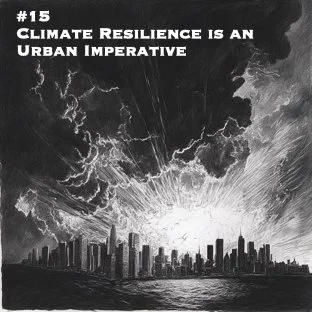Bouncing Back: How Cities Can Adapt and Thrive Amid Frequent Weather Disasters
Does it feel like our cities are under siege? Hurricanes in the south of the US (even far inland), wildfires (on both coasts), heatwaves, and floods—the list grows longer as climate change accelerates. The challenge for cities today is not just to recover from disasters but to do so in a way that makes them stronger, more adaptable, and better prepared for the next event.
Resilience isn't a buzzword; it's a necessity for urban areas that want to thrive in an unpredictable future.
Especially in a world where it feels like our leaders just don't care.
So how do cities, and I really mean the residents, maintain resilience and increase adaptability when faced with an onslaught of weather-related disasters?
Not one and done…
First, cities must acknowledge that adaptation is ongoing, not a one-time fix. Our climate isn't static, something climate deniers use as a crutch but isn't the one they think it is, and neither can our responses be. Investing in resilient infrastructure that can withstand shocks is crucial. For instance, building flood walls or developing levees can mitigate flood damage, but these measures need to be flexible. Rotterdam has pioneered adaptive flood management by designing public spaces that can serve dual purposes—a plaza that is also a reservoir during heavy rains, for example. This kind of thinking transforms disaster risk into an opportunity for better urban design. Climate resilience is an Urban imperative (Law #15 in the 21 laws of cities https://www.utili.city/blog/the-20-laws-of-cities).
Decentralization
Equally important is decentralizing critical systems. During a disaster, cities that rely on one major power plant or water supply can be crippled if that infrastructure fails. Resilient cities must embrace a nodal approach—think multiple microgrids for electricity or neighborhood-scale (heck, even individual home level) water storage—so that a single point of failure doesn’t lead to a complete collapse. Decentralization not only makes cities less vulnerable but also increases their ability to bounce back quickly after an event.
Social Infrastructure
One thing we shouldn't forget is that social infrastructure is just as crucial as physical infrastructure. The resilience of a city lies not only in its buildings and roads but in its people. Cities that foster strong community networks fare better during disasters. After Hurricane Sandy, neighborhoods in New York City with strong community organizations were able to distribute aid, check on vulnerable residents, and adapt more efficiently to the chaos. The recovery is well laid out in the book 'Extreme Cities' by Ashley Dawson. And he outlines that resilience requires investing in community spaces, local organizations, and social programs that create the kind of neighborly ties that lead to real resilience in times of crisis. Reza and myself talked about this in episode 12 of season 1 of Future Forward Cities 'The Future of Emergencies in Cities' https://futureforward.fm/episodes/ep-12-future-of-emergencies-in-cities
Technology
Data and technology also play a key role. Smart cities have a bad rep but they aren’t just about convenience; they're about using real-time information to make fast, informed decisions during an emergency. Sensors that detect rising water levels, or public apps that can warn citizens about an incoming heatwave, are tools that can save lives. However, the use of technology must be inclusive. Resilience planning that relies solely on high-tech solutions can leave behind those without access to technology. Equity is key—everyone in a city needs to be part of the resilience equation (Episode 11: Social Equity in cities: https://futureforward.fm/episodes/ep-11-social-equity-in-cities).
Adaptability also means involving residents in planning and decision-making. Too often, resilience initiatives are top-down, implemented by authorities without community input. But resilience can’t just be engineered; it must be co-created. When residents are engaged in creating local green spaces, designing flood protection measures, or participating in emergency preparedness drills, they are more invested in the outcome. This community involvement fosters a shared sense of ownership and a better understanding of the challenges and solutions.
Lastly, cities must look beyond immediate fixes and think about long-term sustainability. The resilience of today shouldn’t come at the cost of a future burden. For instance, building sea walls might protect against rising waters, but without addressing carbon emissions, it’s merely a short-term solution to an escalating problem. Transitioning to renewable energy, incorporating green spaces that cool urban areas, and building efficient public transit are all part of creating cities that are not only resilient but are contributing to solving the broader climate crisis.
Never bet against (the people in) cities!
Cities have always adapted to change—from industrial revolutions to population booms—and climate change is another, albeit unprecedented, challenge. The pathway forward lies in embracing adaptability as a constant process, building redundancy into critical systems, investing in community, and ensuring equity is designed into the solutions we build. If cities are to survive and thrive amidst frequent weather disasters, resilience must be woven into every aspect of urban planning. It isn’t about bouncing back to what was, but recovering even better than we were before. Let's keep working!


